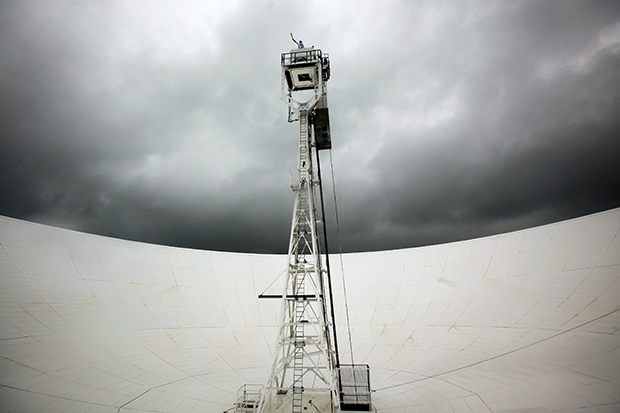It lasted for just a few seconds but was such a graphic illustration of the statistics behind the bombing campaign in Syria — and not a word was spoken. Martha Kearney called it an ‘audio graphic’ on the World at One on Monday and explained how Neal Razzell and James Beard for the World Service had been monitoring the number of US combat missions on Islamic State targets in Syria, hour by hour, 24/7, and comparing them with earlier bombing campaigns. Each electronic beat we heard represents one hour, Razzell told us; each beep represents the launch of one combat mission.
For Syria, the electronic beeps between each beat were quite far apart — clearly distinguishable. The sound we heard represented two raids an hour, he explained, every day for 450 days. Now listen to Serbia in 1999: the beeps were much closer together, but were not quite blurred together into one continuous beeping sound. That’s five US bombing raids per hour, he said. But next we heard his ‘audio graphic’ of the Iraq invasion of 2003. The beeps were a barrage, a shrill blast: 40 raids an hour. And for the second world war, there was an even shriller, more persistent beeping: 70 raids an hour, every day for four years, he explained.
The final clip took us back to Syria in 2015, to those two beeps between a beat. ‘That’s the campaign against Islamic State,’ he repeated, making his point without needing to say more.
Will Self was in combative mood this week in his new Radio 4 series Self Drives (produced by Laurence Grissell) in which he struggles to understand the physics behind James Clerk Maxwell’s theories of electricity, magnetism and light. It’s as if his inability to grasp hold of the ‘elegant equations’ on which our mobile phones, GPS systems, radar and even the radio are based was all the fault of Maxwell and his fellow scientists. He was so rude to his fellow investigator, the physicist Professor Akram Khan, that Khan virtually disappeared from the last programme, probably fed up with being bruised and battered by Self’s repeated verbal onslaughts.
Things began badly on a wet morning in Edinburgh as Self relied on Khan to find their way to India Street (where Maxwell was born) by smartphone. The trouble was the directions they were following were for car drivers, not walkers. Self’s humour did not improve as they took to the road, en route for Cambridge on the trail of Maxwell’s life and work, in the latest version of a hybrid car, a Chevrolet Volt, which they couldn’t charge up because the hire company had failed to provide them with a charging cable (in the end only one mile of their 600-mile journey was fuelled by electricity).
But things got really sticky in Manchester, over a Chinese meal. Self had gone to a lot of trouble preparing for the series, taking lessons in differential calculus, electromagnetism, reading biographies of Maxwell but he was beginning to think he understood even less than he had done to begin with. ‘This should be wondrous,’ he complained to Khan, recalling how as children we get so excited about magnets. But ‘the world your science reveals to me is so much more threatening and minatory’. As scientists, he told Khan, you don’t reflect enough on the unintended consequences of your work. Why should you need a degree in quantum physics to understand how a mobile phone works?
‘You argue the case so well,’ Khan retorted, rather wanly. ‘You hog the discussion with your very lyrical use of language, your internally self-consistent discussion. It’s very difficult to poke holes’.
But Self’s deep scepticism of scientific progress, his willingness to admit that he was failing to grasp the most elemental equations, in spite of hours spent trying to understand them, kept me listening. He was even rude about Jodrell Bank, mocking its Bakelite and Melamine appearance, its 1950s feel, while at the same time in awe of the breadth and scale and potential of that enormous telescope. You can’t forget what he says, with that insistent, lugubrious, unmistakable voice, even if sometimes you wish you could.
On Private Passions on Sunday (Radio 3) the foreign correspondent Christina Lamb told us how, when she first went to Peshawar aged 21, she took with her in her enormous suitcase a large bag of wine gums and a bottle of Chanel No. 5. Her original intention was to become a novelist but she was sidetracked by Benazir Bhutto, whom she interviewed for the Financial Times and who then invited her to her wedding in Pakistan.
Lamb was with her on the campaign bus when Bhutto was assassinated in 2007 by a huge bomb. Everything was on fire around her, orange flames shot through all the trees. There were shoes everywhere, she recalled. People’s shoes had been blown off. Yet she sounded so unfazed by it and the music she chose was calm, meditative, romantic even. It’s as if fear, chaos, violence is normal to her. What she finds difficult is ‘normal’ life. As she told Michael Berkeley, ‘It’s hard for me to be interested in buying tiles for the kitchen.’






Comments